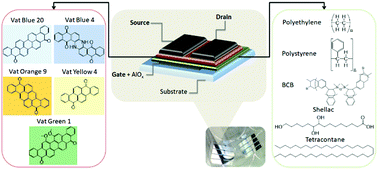Vat dyes: promising biocompatible organic semiconductors for wearable electronics applications†
Abstract
The smart healthcare approach requires continuous monitoring of the individual's specific health parameters to enable disease diagnostics and treatment at early stages. From that viewpoint, wearable electronics, especially electronic skin technology, have a tremendous potential to become an important tool for the realization of such medicine of the future. Since on-skin electronics is placed in direct physical contact with human skin, all materials used to make such devices must be non-toxic, safe, and biocompatible. However, this aspect has been just scarcely explored to date, while many researchers postulate that organic electronics is a priori safe and biocompatible. Herein, we present the first systematic study of five vat dyes, which are commonly used for textile coloration, as prospective organic semiconductors for wearable and on-skin electronics. The best characteristics were achieved for n-type organic field-effect transistors (OFETs) fabricated with Vat Blue 20, Vat Yellow 4, and Vat Orange 9 as semiconductor materials. It has been shown that the choice of the dielectric strongly affects the device performance, so the highest charge carrier mobilities were obtained in OFETs using less polar dielectric materials with low surface energy such as tetracontane or polyethylene. In the second part of the study, we assessed the biological activity of a series of vat dyes and a panel of the reference semiconductors: pentacene, DNTT, ADT and fullerene C60 using the human embryo lung fibroblasts cell line as a model system. The impact of the evaluated organic semiconductor materials on the cells varied greatly: severe DNA damage and changes in the cell morphology were induced by such semiconductors as fullerene or pentacene, whereas vat blue 20 and vat orange 9 were found to be almost non-toxic since the response of the cells was very similar to the control samples. Thus, we demonstrated that conventional semiconductor materials might be too toxic for their use in contact with human body tissues, while some of the vat dyes show good biocompatibility profiles which makes them highly promising and safe materials for electronic skin and other wearable electronics applications.



 Please wait while we load your content...
Please wait while we load your content...